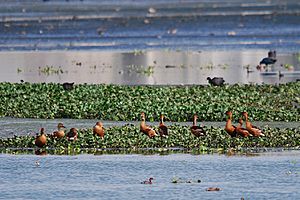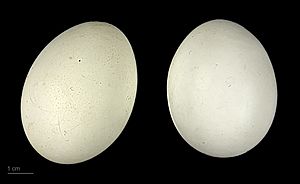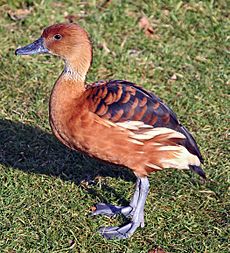Fulvous whistling duck facts for kids
The fulvous whistling duck (Dendrocygna bicolor) is a type of whistling duck. It lives in warm, tropical parts of the world. You can find it in much of Mexico, South America, the Caribbean, the southern United States, Africa, and India.
This duck has feathers that are mostly reddish-brown. It has long legs and a long grey bill. When it flies, you can see a clear white band across its black tail. Like other whistling ducks, it makes a whistling sound. It calls while flying or when it's on the ground.
Fulvous whistling ducks like to live in wetlands with lots of plants. This includes shallow lakes and rice fields. Their nest is made from plant material and has no soft lining. They build it among thick plants or in a tree hole. A female usually lays about ten whitish eggs. Both parents, who stay together for life, take turns sitting on the eggs. The eggs hatch in 24 to 29 days. The fluffy grey ducklings leave the nest within a day of hatching. Their parents protect them until they can fly, which is about nine weeks later.
These ducks eat seeds and other plant parts from wetlands, both day and night. Sometimes, they are seen as a problem for rice farms. People also hunt them for food in some areas. Even with hunting, pesticides, and natural predators, there are many fulvous whistling ducks. They live in a very large area. Because of this, they are listed as a species of least concern by the International Union for the Conservation of Nature. This means they are not currently in danger of disappearing.
Quick facts for kids Fulvous whistling duck |
|
|---|---|
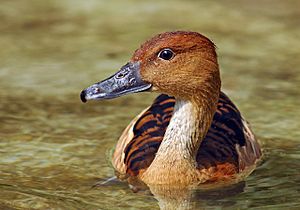 |
|
| Adult at the Wilhelma zoological and botanical gardens in Stuttgart | |
| Conservation status | |
| Scientific classification | |
| Genus: |
Dendrocygna
|
| Species: |
bicolor
|
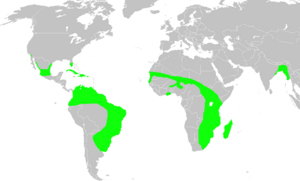 |
|
|
Approximate breeding range
|
|
Contents
About Whistling Ducks
Whistling ducks are a special group of eight bird species. They belong to the duck, goose, and swan family, called Anatidae. These ducks look a bit different. They have a hump on their back, a long neck, and make whistling sounds when they fly. That's how they got their name!
These ducks are an old part of the duck family tree. The fulvous whistling duck is very similar to the wandering whistling duck.
Naming the Fulvous Whistling Duck
The fulvous whistling duck was first described in 1789. But its first name was already used for another bird. So, in 1816, a French bird expert named Louis Jean Pierre Vieillot gave it a new name: Anas bicolor.
Later, a British bird expert, William Swainson, moved these ducks to their own group, called Dendrocygna. This name comes from ancient Greek and Latin words. Dendron means "tree," and cygnus means "swan." The word bicolor is Latin for "two-coloured," which describes the duck's feathers.
The word "fulvous" means reddish-yellow. It comes from the Latin word fulvus. People have also called this duck by other names, like brown tree duck or Mexican duck.
What the Fulvous Whistling Duck Looks Like
The fulvous whistling duck is about 45 to 53 centimeters (18 to 21 inches) long. Males usually weigh between 748 and 1050 grams (1.6 to 2.3 pounds). Females are a little lighter, weighing 712 to 1000 grams (1.5 to 2.2 pounds). Their wings can spread out from 85 to 93 centimeters (33 to 37 inches).
This duck has long legs and is mostly different shades of brown. Its head, neck, and chest are a rich reddish-yellow color. Its back is darker brown. A dark stripe runs from the top of its head down its neck. It has whitish stripes on its sides, a long grey bill, and grey legs.
When it flies, its wings are brown on top and black underneath. It doesn't have white marks on its wings. There's a white crescent shape on its rump that stands out against its black tail. Both male and female ducks look quite similar. Young ducks are paler and look duller overall.
After breeding, these ducks lose all their flight feathers. They hide in thick wetland plants until new feathers grow, as they cannot fly during this time.
Sounds and Calls
These ducks are quite noisy birds! They make a clear whistling sound that sounds like kee-wee-ooo. You can hear this call when they are on the ground or flying, often at night. If ducks are arguing, they make a harsh, repeated kee sound. When they fly, their wings make a dull sound.
Male and female calls are different. Experts can even tell if a duck is male or female just by listening to its call!
Where They Live and Their Home
The fulvous whistling duck lives in a very large area across four continents. They breed in South America, from northern Argentina up to Colombia, and then into the southern US and the West Indies. They are also found across Africa, south of the Sahara Desert, and down to South Africa and Madagascar. India and nearby countries are also a big home for them in Asia.
These ducks move around depending on where they can find water and food. African birds move south in the summer to breed and return north in winter. Asian ducks move a lot because rainfall changes. This species has spread its range in Mexico, the US, and the West Indies in recent years. They like areas where rice is grown.
Fulvous whistling ducks live in lowland marshes and swamps. They prefer open, flat areas, like rice fields, and avoid places with many trees. They usually don't live in mountains.
Daily Life and Habits
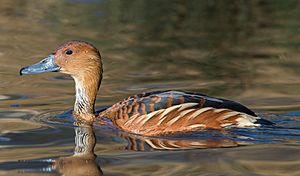
These ducks are usually seen in small groups. But many ducks can gather in their favorite spots. They walk well without waddling. They usually feed by tipping their bodies upside down in the water. They can also dive if they need to. Unlike some other whistling ducks, they don't often perch in trees.
When they fly, they stay low with slow wingbeats and their feet trailing behind them. They fly in loose groups, not in a tight formation. They eat during the day and night, often with other types of whistling ducks. But they rest or sleep in smaller groups in the middle of the day. They are noisy and show they are upset by throwing their heads back. Before flying away in alarm, they often shake their heads sideways.
Reproduction and Life Cycle
Fulvous whistling ducks breed when there is enough water. In South America and South Africa, they nest from December to February. In Nigeria, it's from July to December. In North America, it's from mid-May to August. In India, the breeding season is from June to October. Fulvous whistling ducks stay with the same partner for their whole lives.
Pairs might breed alone or in loose groups. Nests can be close to each other in some areas. The nest is about 19 to 26 centimeters (7.5 to 10 inches) wide. It's made from plant leaves and stems and has little soft lining. Nests are usually built on the ground in marsh plants or in rice fields. Sometimes, they are built in tree holes. In India, using tree holes or even old nests of other birds is more common.
Eggs are laid about every 24 to 36 hours. The female starts laying before the nest is fully built. The eggs are whitish and weigh about 50.4 grams (1.8 ounces). A typical clutch has about ten eggs. However, other females sometimes lay their eggs in the nest, so you might find 20 or more eggs! Eggs can also be laid in the nests of other duck species.
Both parents sit on the eggs, taking turns once a day. The male often does more of this job. The eggs hatch in about 24 to 29 days. The fluffy ducklings are grey with lighter upper parts and a white band on their neck. They weigh about 22 to 38 grams (0.8 to 1.3 ounces) when they hatch. Like all ducklings, they are able to move around soon after hatching. They leave the nest after a day or so. Their parents protect them until they can fly, which is about nine weeks later.
Mammals, birds, and reptiles sometimes eat the eggs and ducklings. One parent might pretend to have a broken wing to distract a predator. Meanwhile, the other parent leads the ducklings away to safety. These birds can start breeding after one year. The oldest known fulvous whistling duck lived to be 6.5 years old.
What They Eat
The fulvous whistling duck eats in wetlands during the day or night. They often feed in mixed groups with other whistling ducks. Their food is mostly plants, including seeds, bulbs, grasses, and stems. However, female ducks might eat small animals like aquatic worms, snails, and insects when they are getting ready to lay eggs. These animal foods can make up a small part of their diet. Ducklings might also eat a few insects.
They find food by picking up plant pieces while walking or swimming. They also tip their bodies upside down in the water. Sometimes, they dive up to 1 meter (3 feet) deep to find food. They like to eat plants like water snowflake, aquatic ragweeds, and various types of grasses. Rice is usually a small part of their diet. However, in some areas like Louisiana, rice can make up a quarter of the diet for females sitting on eggs.
Conservation Status
The International Union for the Conservation of Nature (IUCN) estimates there are between 1.3 and 1.5 million fulvous whistling ducks worldwide. Some regional studies suggest the number might be even higher, possibly over 2 million ducks globally.
The number of these ducks seems to be going down. However, the decrease is not happening fast enough to make them a threatened species. Because there are so many of them and they live in such a huge area, the IUCN classifies this duck as a species of Least Concern. This means they are not currently in danger of extinction. This duck is also protected by an agreement for migratory waterbirds in Africa and Europe.
The fulvous whistling duck has spread its home range in the West Indies and into the southern US. They started moving into the eastern US around 1948, helped by the growth of rice farms. Breeding was seen in Cuba in 1964 and Florida in 1965. Some Florida birds still spend their winters in Cuba.
Outside North America, people hunt these ducks for food or because they eat rice. In Madagascar, they are now rare because of this. Pesticides used on rice fields can also harm them, even in small amounts.
Images for kids
See also
 In Spanish: Sirirí colorado para niños
In Spanish: Sirirí colorado para niños



